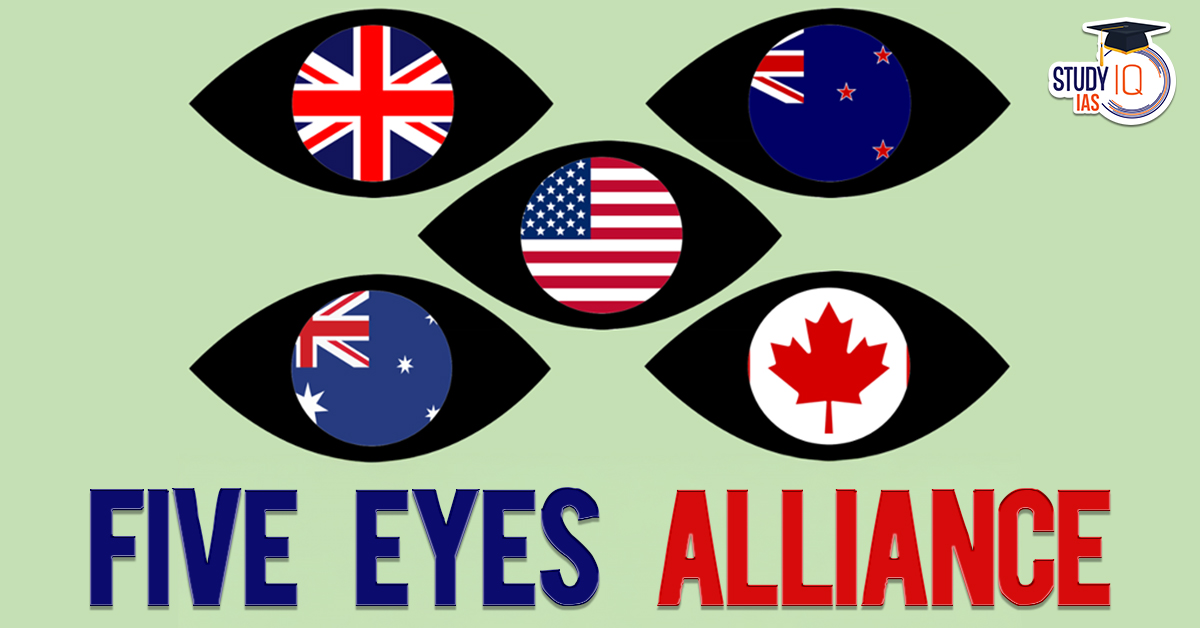Table of Contents
Context: The Five Eyes alliance now faces an unprecedented internal crisis. Recently Intelligence chiefs of Five Eyes Alliance countries attended the Security Conclave organised by the National Security Council Secretariat.
About Five Eyes Alliance (FVEY)
- It is an intelligence-sharing network comprising 5 English-speaking countries.
- USA, United Kingdom, Canada, Australia and New Zealand.
- It was established in the aftermath of World War II, its roots trace back to the UKUSA Agreement signed in 1946, which aimed to facilitate cooperation in signals intelligence (SIGINT) among these nations.
Objectives of the Five Eyes Alliance
- Intelligence Sharing: The primary objective is to collect, analyse and share intelligence on global threats, including terrorism, cybercrime and other security challenges.
- National Security Enhancement: By pooling resources and intelligence, the Five Eyes nations aim to bolster their national security capabilities and respond more effectively to emerging threats.
- Signals Intelligence (SIGINT): FVEY focuses heavily on SIGINT, which involves intercepting and analysing electronic communications. This includes monitoring phone calls, emails, and internet activities.
| Facts |
|
Background and Formation of the Five Eyes Alliance
Formation During World War II
- The Five Eyes alliance was formed during World War II, initially between the US and the UK to intercept and decode enemy communications.
- The intelligence-sharing agreement was formalized in 1946 between the US and UK.
Expansion of Membership
- Canada joined in 1948 and Australia and New Zealand in 1956.
- The alliance focused on Signals Intelligence (SIGINT) of common interest among the Anglosphere (English-speaking nations with shared political, legal, and cultural traditions).
Cold War and Post-9/11 Role
- During the Cold War, the alliance monitored Soviet and Warsaw Pact communications.
- After 9/11, it expanded to cover counterterrorism and cybersecurity.
- Recently, it shifted focus to China, warning against risks from Huawei in 5G networks (2018).
- Encouraged both Western and non-Western nations to exclude Huawei from infrastructure.
Growing Political Crisis in the Five Eyes
Trump’s Radical Foreign Policy Shifts
In Donald Trump’s second term, US foreign policy has shifted dramatically:
- Seeking rapprochement with Russia.
- Pushing for a ceasefire in Ukraine.
- Weakening the EU and NATO.
- Dismantling the post-war US-Europe strategic consensus.
- These moves have strained Washington’s relationship with European allies and the broader Western alliance.
Disputes with Canada
Reports emerged that Trump’s aides were considering expelling Canada from the Five Eyes due to trade and border tensions. The White House denied these reports.
- Trump launched an aggressive trade war against Canada, a key trading partner.
- Suggested that Canada should become the “51st state” of the US.
- Claimed the US-Canada border is arbitrary.
Territorial Disputes
Trump proposed annexing Greenland (a territory of Denmark), which is seen as a direct challenge to Anglo-American allies.
Tensions with Britain
At a conservative gathering, US Senator J.D. Vance described Britain as the “first Islamist country” to have nuclear weapons, comparing it to Iran and Pakistan.
- Trump’s “Make America Great Again (MAGA)” movement sees Britain as a failing state dominated by excessive regulation and liberal politics.
- American right-wing resents the global liberal establishment, including European and Anglosphere elites.
Opportunities for India Amid the Five Eyes Crisis
Enhanced Intelligence Cooperation
With growing instability within the Five Eyes, India can position itself as a reliable intelligence partner.
- India’s experience in counterterrorism, cybersecurity, and regional intelligence (especially concerning China and Pakistan) makes it a valuable ally.
- India can negotiate intelligence-sharing agreements with Five Eyes members on a bilateral or multilateral basis.
Strategic Partnerships in the Indo-Pacific
The Five Eyes’ increasing focus on the Indo-Pacific aligns with India’s strategic interests (e.g., QUAD and AUKUS).
- India can deepen defence and intelligence ties with the US, Australia, and Japan to counter China’s influence.
- Expanding naval cooperation and joint exercises (like Malabar) can strengthen India’s position in the region.
Military-Industrial Collaboration
- India can explore deeper defence collaboration with the Five Eyes nations, especially in advanced technology (e.g., drones, cybersecurity, AI).
- India’s defence industry can benefit from technology transfers and joint ventures with Five Eyes members, particularly in the naval and aerospace sectors.
Diplomatic Leverage
- India’s balanced ties with both Western and non-Western nations position it as a bridge between the Five Eyes and the Global South.
- India’s independent foreign policy and non-alignment stance allow it to mediate between Western and Eastern powers.
Cybersecurity and Technology Sharing
- India can propose joint initiatives with the Five Eyes on cybersecurity and digital infrastructure protection.
- India’s growing expertise in IT and digital infrastructure can make it a key partner in securing global communication networks.


 United Nations General Assembly (UNGA), ...
United Nations General Assembly (UNGA), ...
 Universal Postal Union (UPU), Objective,...
Universal Postal Union (UPU), Objective,...
 World Meteorological Organisation (WMO),...
World Meteorological Organisation (WMO),...




















